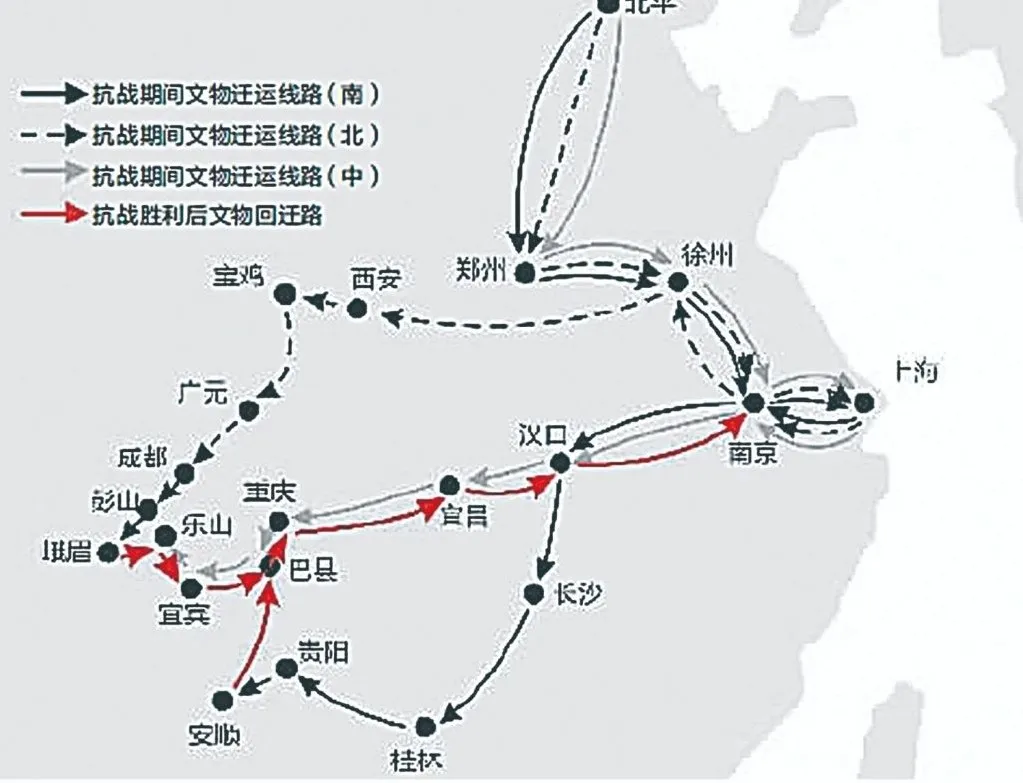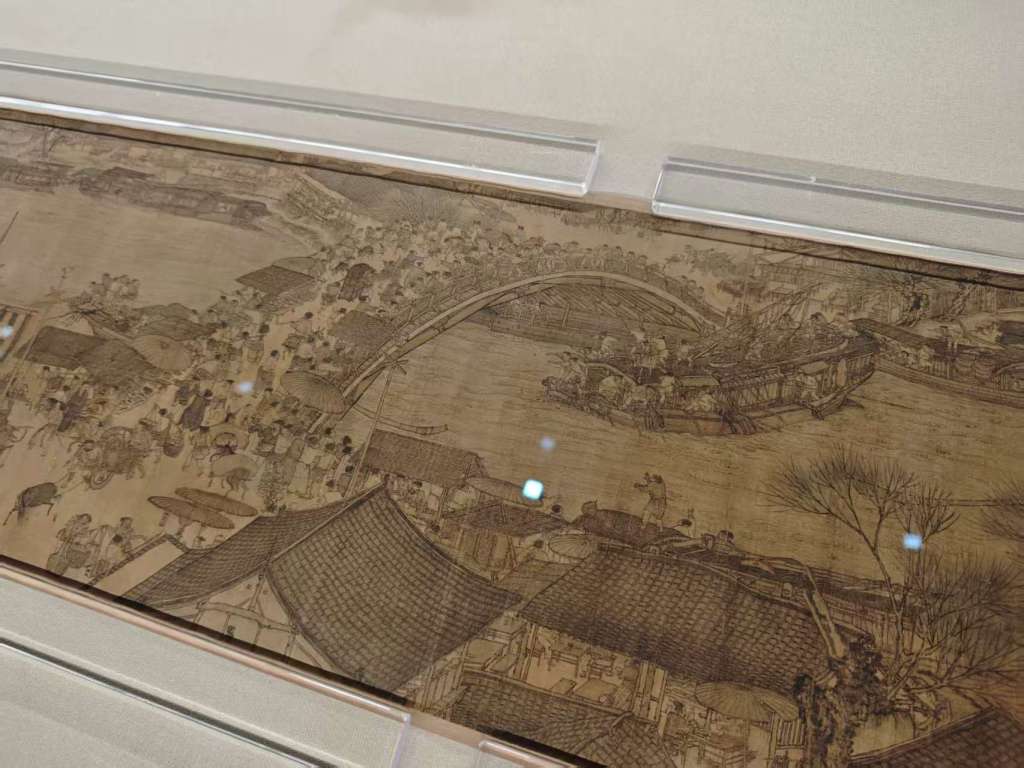
Color painting has a long history in China. "Carved beams and painted buildings" are synonymous with exquisite and magnificent ancient Chinese architecture. The most representative of ancient Chinese color paintings is the official style color painting, which is characterized by clear decorative patterns, strict grades and standards, and exquisite craftsmanship and materials.
The Paper learned that on May 27, the "Thousand Years of Color Paintings: The Inheritance and Innovation of Chinese Official Color Paintings" exhibition was opened to the public in the Yongshou Palace exhibition hall of the Palace Museum. In the Forbidden City, a treasure house of Ming and Qing official architectural colored paintings, we can see the aesthetic wisdom and thousand-year continuity of ancient Chinese colored painting art. Among them, five precious sketches of the "Yingzao Fashi" colored painting research hand-painted by Mr. Liang Sicheng (with Mr. Zhu Qiqin's annotations) collected by the "China Construction Society Memorial Hall" of the School of Architecture of Tsinghua University were exhibited for the first time.

Liang Sicheng's manuscript of Song Dynasty five-color square wins Luo
Color painting, as an important factor in the image of ancient Chinese architectural art, has the main function of decoration and distinction. Through the exquisite combination of lines and colors, the building is given a splendid costume. Color painting carries the wisdom of the ancients' "harmony between man and nature", and has the decorative effect of "the color of the sun and the moon, the color of the gold and the mist". Painting on buildings is not only an aesthetic requirement, but also has the practical significance of social etiquette and the protection of wooden components. As early as in "The Analects of Confucius", there was a record of "mountain knots, algae and palm trees", and "The Book of Rites" recorded: "The pillars are red for the emperor and dark for the princes". Archaeological evidence that there were colored paintings on ancient buildings is the Qin Palace No. 3 in Xianyang, Shaanxi, where murals of carriages and horses painted on the walls were excavated.
Throughout history, colored paintings have left a deep impression on people with their unique style, unique production techniques and magnificent decorative art effects, and have become the essence of traditional architectural art and have been recorded in history.

Entrance to the Yongshou Palace exhibition hall of the Palace Museum
It is reported that this "Thousand Years of Color Painting - Inheritance and Innovation of Chinese Official Color Painting" is divided into two major sections: the "upholding the orthodoxy" of the front hall of Yongshou Palace and the "innovation" of the back hall. Although the number of exhibits is small, they are all selected works of color paintings from past dynasties, and many exhibits are exhibited to the public for the first time.

The "Shouzheng" section of the front hall of Yongshou Palace
Among them, the "upholding the orthodoxy" section consists of seven units, carefully selecting 43 copies and sample paintings of representative works of Chinese official architectural paintings from the Sui Dynasty to the Qing Dynasty. The "innovation" section consists of four units, selecting the works of outstanding students of the National Art Fund's art talent training project.

Yongshou Palace rear hall "innovation" section
The concept of "big color painting" was first proposed, showing the charm of architectural color painting from plane to three-dimensional
The exhibition brings together precious collections and academic achievements from many museums, research institutions and universities, including the Palace Museum, Dunhuang Academy, Chinese Cultural Heritage Research Institute, Tsinghua University School of Architecture "China Architectural Society Memorial Hall", Tianjin University School of Architecture, etc. It is the first time that the academic concept of "big color painting" was proposed, connecting the caisson color paintings, mural borders and cave eaves color paintings of the Tang and Song dynasties in the Mogao Grottoes in Dunhuang with the official color paintings of the Ming and Qing dynasties in the Palace Museum into an organic whole, opening up the historical context of the development and evolution of Chinese official color paintings.

Painting of lotus-shaped children on the ridge of the Mogao Cave 427 in the Sui Dynasty, copied by Li Qiqiong and Ouyang Lin (1959), Collection of the Dunhuang Academy

Eaves paintings of Cave 427 and Cave 431 of Mogao Grottoes in the Northern Song Dynasty, copied by Sun Ruxian (1940s), collection of Dunhuang Academy
Five precious sketches of the Song Dynasty's "Yingzaofashi" painting research hand-painted by Mr. Liang Sicheng (with annotations by Mr. Zhu Qiuqun) collected by the "China Architectural Society Memorial Hall" of the School of Architecture of Tsinghua University are exhibited for the first time.

Liang Sicheng's manuscript, Song Dynasty, Five-color sea pomegranate flowers
This exhibition focuses on the full display of architectural paintings as a spatial decorative art from flat to three-dimensional. The exhibits are in various forms, including painting copies, samples, restoration drawings and painted bracket models.

Model of a Song Dynasty five-color painted bracket set
The works exhibited for the first time also include the latest research results of two generations of scholars from the Ancient Architecture Department of the Palace Museum on the restoration of the colorful dougong painted in the Song Dynasty's "Yingzaofashi". At the same time, the latest results of the Ming Dynasty gold-threaded stone-milled jade dougong model are displayed for comparison. Through the model, we can get a glimpse of the development and evolution of dougong painted colors and patterns from the Tang and Song Dynasties to the Ming and Qing Dynasties.

Model of a painted jade dougong with gold thread and stone mill from the Ming Dynasty
Among the real objects in the Forbidden City, see the official colored paintings of Ming and Qing Dynasties
The exhibition focused on the exquisite samples of Ming and Qing Dynasty colored paintings drawn by famous colored painting masters He Wenkui and Zhang Decai in the Palace Museum, including samples of Ming and Qing Dynasty official colored paintings in many non-open areas such as Nanxun Hall, Yangxin Hall, Chuxiu Palace in the Ming Dynasty, Dagaoxuan Hall, Xuanqiong Hall, Biluo Pavilion in the Qing Dynasty. It also exhibited the research and contribution of colored paintings by Mr. Wang Zhongjie, a master of Chinese official architectural colored paintings, for the first time.

Late Ming and Early Qing Dynasty, A Sample of the Hexi Color Painting on the Ridge of the Main Hall of the Dagaoxuan Hall, Copied by He Wenkui and Zhang Decai (1950s), Collection of the Palace Museum

Hand-drawn sketch by Mr. Wang Zhongjie
In order to let the public better understand traditional crafts, the research results of the "Restoration of Color Painting Construction Skills" completed by the team of the Palace Museum's Ancient Architecture Department in recent years, which is a key research and development plan of the 13th Five-Year Plan, are exhibited for the first time. Taking the Hexi colored paintings of the Yongshou Palace and the Su-style colored paintings of the Wenyuan Pavilion in the Palace Museum during the Qing Dynasty as examples, the charm of the craftsmanship of the Qing Dynasty as the last peak of the development of official colored paintings is displayed from the aspects of process, materials, and techniques.

Exhibition View
The 2024 National Art Fund Art Talent Training Project "China Official Color Painting Pattern Art Design Creative Talent Training" Achievement Exhibition is exhibited in the rear hall. Based on the color painting pattern elements, it highlights the process from the research and restoration of the Nanxun Hall color painting, the use of colors, all-round three-dimensional modeling and rendering to pattern extraction, and the cultural and creative design from two-dimensional to three-dimensional (video interaction), so that the ancient color painting can be transformed from static to animated, creating a young state of color painting, and completing the creative transformation and innovative development of the official architectural color painting pattern art.
Creative works created by students on themes such as "The Fragrance of the South Wind", "The Power of Cloud Dragon" and "The Prosperity of Flowers and Brocade" are displayed here, allowing the painted patterns to better beautify people's lives.

Passionflower ceiling painted silk scarf series from the Qing Dynasty - "Green Lotus Dream" square scarf
In addition, this exhibition combines traditional color painting art with modern technology for the first time, integrating color painting techniques into digital interaction, allowing visitors to experience and interact with the charm of traditional architectural color painting at close range. The exhibition will last until August 26.
(This article is based on relevant documents from the Palace Museum)


